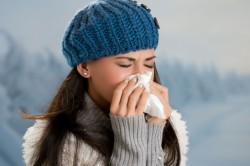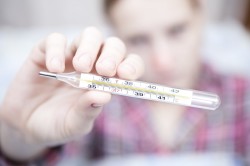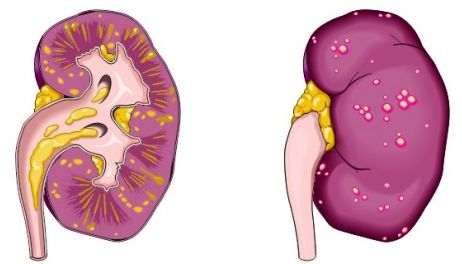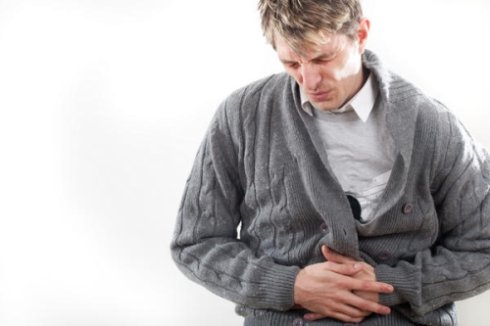If the lower back and the temperature are aching, then it is quite possible that this is not just overwork. The body always gives signals that it is hard for him. There is such a thing as psychosomatics, when psychological problems pass to the body. For example, if a person is nervous a lot, he may develop psoriasis or a sore throat.
But not all symptoms can be explained by psychology. Many signs point to serious violations. This applies to pain in any part of the body.
Why does the lower back hurt and the temperature appears? These symptoms may indicate several diseases. It is necessary to take into account their nature and accompanying signs, for example, when not only the back, but also the head feels sick or hurts.
Influenza as the cause of the problem
 This disease is known to all. It is accompanied by a temperature (usually 37-38 °), general weakness. In some cases, a person can feel sick and even vomit. To this may be added pain in the lower back, especially in the process of coughing.
This disease is known to all. It is accompanied by a temperature (usually 37-38 °), general weakness. In some cases, a person can feel sick and even vomit. To this may be added pain in the lower back, especially in the process of coughing.
Influenza is a disease that can lead to a lot of complications. First of all, there is a risk of pneumonia or lung abscess. Such processes quite often affect the lower back and give pain throughout the back. To prevent such an unpleasant situation from happening, you should respond to the disease in a timely manner and take all measures to eliminate it. It is best not to stop only on painkillers and antiviral drugs, but to additionally use antibiotics.
But drug treatment it is necessary to start after examination by a specialist, since any drug has side effects and contraindications.
Symptoms of pyelonephritis
 This disease should be given special attention, as it is associated with the kidneys and poses a great threat. The first symptom of such an ailment is a temperature (37 °), and it rises suddenly. The body always reacts to any inflammatory process, even a minor one, with temperature, letting you know that there is a problem inside.
This disease should be given special attention, as it is associated with the kidneys and poses a great threat. The first symptom of such an ailment is a temperature (37 °), and it rises suddenly. The body always reacts to any inflammatory process, even a minor one, with temperature, letting you know that there is a problem inside.
Further, with pyelonephritis, a person begins to complain that he is sick, after which severe pain begins in the lower back. Since this disease is associated with the kidneys, the pain will be localized only on one side. She has a dull whining character. As for its intensity, there can be many options, it all depends on the stage of the disease, but there will be especially sharp attacks during coughing or sneezing. With pyelonephritis, the urination system is not affected, that is, the person has no problems in this area. Because of this, the necessary measures are not taken.
If it hurts in the lower back on only one side, you should immediately contact a medical facility.
If the condition does not allow this, then you need to call an ambulance. Ignoring such dangerous symptoms can lead to a chronic form of the disease, which entails the constant presence of pyelonephritis, which reminds of itself with strong pain, in addition, there is a risk of purulent formations.
Pain caused by muscle injury
 Sometimes back pain occurs after excessive physical exertion. Usually this can be caused by physical education classes, when a beginner starts exercising without prior preparation, or ordinary household chores, such as moving furniture or digging potatoes. In most cases, the pain goes away on its own after a couple of days, the main thing is not to burden the back and lower back, to ensure peace.
Sometimes back pain occurs after excessive physical exertion. Usually this can be caused by physical education classes, when a beginner starts exercising without prior preparation, or ordinary household chores, such as moving furniture or digging potatoes. In most cases, the pain goes away on its own after a couple of days, the main thing is not to burden the back and lower back, to ensure peace.
If the matter is in the muscles, then the pain may be dull, aching or shooting in nature. And it manifests itself precisely at the moment of loading. Such a problem can also arise due to the fact that a person has been in a draft for a long time or. To make this period easier, it is recommended to use special ointments or injections that have an analgesic effect.
If, in addition to pain, there is a temperature up to 37 °, you should pay special attention to your body, since an inflammatory process may have begun. If there is such a symptom, then in no case should you use warming ointments, as this can only harm. To make it easier, it is best to take a horizontal position. This will help relax the back muscles.
But if the pain returns from time to time, then it is best to seek help from a specialist, since the muscles could be injured from sudden or excessive loads. To avoid problems with the spine, timely professional help is needed. This problem is usually fixed by:

- manual therapy;
- massage course;
- acupuncture and physiotherapy.
It is better not to choose such methods on your own, because. only a doctor will be able to determine what the problem is during the examination. And if you do it yourself, then the wrong massage can only harm.
The cause of pain can be osteomyelitis and tuberculosis of the spinal column. These diseases have similar symptoms - back pain and fever. Moreover, discomfort in the back will pester the patient incessantly. These diseases are extremely rare today, but such a problem cannot be ruled out.
Self-medication in this case is unacceptable, as there is a possibility of death.
Additional symptoms
In addition to back pain and fever, there are other signs that may indicate possible cause such a state:

- Stomach ache. If such a symptom is observed in a woman, then most likely she has cystitis. It also provokes a rise in temperature, and with such a disease, spotting is observed in the urine, and urination causes pain. The more advanced the cystitis, the stronger the sensations. As for the male, abdominal pain may indicate problems with the digestive or genitourinary system. In addition, the temperature, pain in the back and abdomen causes prostatitis. Since there are several options that can provoke such a situation, it is extremely necessary to consult a doctor in order to specify the diagnosis. Any delay can adversely affect many functions of the body.
- If the lower back pain is accompanied by a feeling of nausea, then there is a risk that the stomach (ulcer) or duodenum has suffered. The same symptoms indicate appendicitis, and nausea often ends in vomiting.
If the pain in the lower back is too severe, and the temperature does not drop even after antipyretic drugs, then there may be a tumor in the spine. A similar picture is observed in inflammatory processes of the pancreas or when one of the vertebral discs is pinched.
If independent attempts to correct the situation fail (taking medication, rest, etc.), the state does not change, then a signal of a poor state of the body. In any case, at the first alarming symptoms, it is necessary to seek qualified help. While waiting for an ambulance or before seeing a doctor, you should remember the nature of the sensations, as this will help speed up the diagnosis and shorten the list of tests and studies, as well as avoid not only complications, but also death.
A person may suddenly develop back pain and fever at any time. What is the reason and what to do? These signs occur with a large number of diseases, let's look at them in more detail. Overexertion, mechanical impact and a sharp awkward movement lead to a back injury, but if the patient is overcooled or overworked, his immunity drops, and he becomes susceptible to various infections. With infections, the body begins to fight with the help of the process of inflammation and raising the temperature.
Here are the main problems when the temperature rises with back pain:
Mechanical injury
Stretching the muscles or ligaments in the back during physical overexertion or an awkward turn, a sharp lifting of weight, you get back pain. They can be blunt, sharp, cutting or aching. If this happens, you need to give the body peace and use an ointment with an analgesic, warming and anti-inflammatory effect. But if the temperature rises with back pain, this is an indicator of the presence of inflammation. In this situation, lower back pain must be removed with non-steroidal anti-inflammatory drugs - tablets, ointment or injections that the doctor will select for you. It is contraindicated to warm up the lumbar region, because this can only worsen the situation.
Among possible injuries back there is a displacement of the vertebrae with pinching of the intervertebral disc. In this case, the disk may eventually lose its shape, becoming flatter, and the performance of its functions will be disrupted. Also, the membrane surrounding it may be damaged in the disc, and a bulge may appear on it - a protrusion, which, without appropriate treatment, eventually turns into a herniated disc.
Vertebral subluxation, disc pinching, protrusion and hernia can cause pressure on the nerve endings - the roots of the spinal cord, from which inflammation begins, accompanied by an increase in body temperature, which is not knocked down by antipyretics.
At the same time, the lower back or other affected part of the spine hurts a lot, especially during movement.

- Be sure to read:
What to do in this case? Contact a doctor who will select non-steroidal anti-inflammatory drugs to relieve inflammation, and after the inflammation and pain are removed, prescribe a course of physiotherapy. It could be:
- Massage that will restore muscle tone and relieve their excessive tension;
- Manual therapy, with the help of which subluxations of the vertebrae and pinching of the intervertebral discs are reduced;
- Acupuncture;
- Exercise therapy, which will help distribute the correct load on the back muscles.
Pyelonephritis
This is an inflammation of the kidneys. Its symptoms are severe back pain and a temperature of 37°-38° C. Nausea or vomiting may be added to this. If one kidney is inflamed, then the back will hurt aching dull, but severe pain on one side of the back, with inflammation of both kidneys - on both sides. In this case, the pain will increase with steps, coughing and light tapping on the back. Swelling of the legs and face may appear, especially in the morning, after sleep, urination disorders are possible, but they may not occur.
- Read also:
Pyelonephritis is a serious and dangerous problem, and at its first signs it is necessary to urgently call a doctor, because if this disease is not cured in time, it remains in a chronic form, periodically aggravating.
In the worst case, you can earn an abscess or carbuncle - this is purulent processes requiring surgical intervention, without which they lead to acute renal and renal-hepatic failure and irreversible dysfunction of the kidneys and liver, ending in sudden death.
Therefore, with a temperature and pain in the lower back with suspicion of pyelonephritis, urgently seek medical help! Also, lower back pain with a temperature of 37 ° C or more may occur due to other kidney problems, such as renal artery thrombosis or colic in nephrolithiasis. In the first case, observation by a doctor is mandatory, everyone knows how unexpectedly a blood clot can cause death. In the case of kidney stones, during colic, pain can be relieved with an antispasmodic, but be sure to undergo an examination by a urologist, who will determine the degree of the disease and prescribe the appropriate treatment.
Flu
If you have back pain and a temperature of 37 ° C and above, general weakness, aching bones and joints, nausea and vomiting, diarrhea, sore throat, cough, runny nose, itchy eyes, watery eyes and headache, these are flu symptoms. Some of them may appear, and some may be absent.
It is believed that the flu is easy to beat at home, but it is often dangerous for its complications, such as sciatica, pneumonia, or lung abscess. These complications cause back pain when coughing.
- We recommend reading:
In order to avoid these unpleasant consequences, it is recommended to urgently seek medical help, so that along with painkillers and antiviral drugs, you will be prescribed adequate antibiotic treatment.
Cystitis
Back pain and a temperature of 38 ° C may indicate a disease. Most often it happens in women. In addition to back pain, cystitis is defined by the following symptoms: abdominal pain, painful urination, or blood in the urine. If you have such symptoms, call the doctor, he will prescribe treatment and cystitis will quickly leave you.
Prostatitis
When men begin to have back pain and the temperature of 37 ° C lasts for a long time without falling, the stomach hurts, in the perineum and testicles and urination is disturbed - weak pressure or pain - these are signs of prostatitis. If left untreated, it turns into a chronic form with periodic exacerbations, during which a debilitating high temperature rises.
The consequences of neglected prostatitis are infertility, impotence or cancer, it is treated for a long time, but in the first stages, before it becomes chronic, it is possible to cure the disease quickly and completely.
Spinal tumor
With severe pain and a temperature that does not decrease even after taking antipyretics, one can suspect a column. Self-treatment is strictly prohibited, be sure to contact a specialist - an oncologist who will determine the quality of the tumor, the nature of the course of the disease and outline a treatment plan.
Tuberculous spondylitis and osteomyelitis
If the back hurts, the temperature is 37 ° - 37.2 ° C, the cause may be a rare disease leading to lethal outcome without appropriate treatment. Therefore, with pain in the lower back or spine and a temperature of unclear etiology, urgently visit a doctor to exclude or cure possible or osteomyelitis.
Text: Zoya Andreeva
Of course, a cold of the lower back is more of a philistine name for an illness than a strict medical diagnosis. But no matter how we call the problem, it will not get easier: if a cold has caught up and at the same time “grabbed” the lower back, urgent measures must be taken to save the back.
Why does the lower back often hurt with a cold?
It's no secret that most of the symptoms of a cold or flu are signs that the body is actively fighting the disease. including the so-called lower back cold- this is a sure sign that the immune system does not sleep, but fights the infection.
The fact is that when a cold or flu virus enters our body and ends up in the circulatory system, the immune system is instantly activated. As a result, an increased amount of interferon, interleukin and other protective substances begin to be released into the blood. Their temporary excess in the blood is the reason that we are in a fever (the temperature rises). At the same time, the metabolic process is disturbed, blood supply increases in those parts of the body where it is necessary for get well soon, and blood flow is sharply reduced where it "can wait." That is why during the flu or a cold we lose our appetite, experience muscle weakness and aching joints - because the blood "bypasses" the stomach, muscles, joints. And often the brain - and this explains the fact that during illness, even super-smart individuals turn into slow-witted ones for a while. For the same reason, we often experience colds and lower back pain.
How to relieve pain from a cold in the lower back?
From a cold of the lower back, warming up will help. But not in the form of a hot bath or a steam room in a bath - these procedures are categorically contraindicated at high temperatures, since in this case the load on the heart and blood vessels increases several times. It is best to warm up the back with the help of pharmaceutical ointments or special devices - heating pads, belts made of dog hair, a large woolen handkerchief, and also with the help of a warming drink.
Usually, with flu and colds, doctors advise lying down for several days to help the body cope with the disease. But if, among other symptoms of a cold, you also experience lower back pain, do not lie for more than two days. The fact is that from a lack of movement, the muscles and joints “stagnate” and this can only increase back pain. It is necessary to move, but in moderation - we are not talking about going to the fitness room, but only about ensuring that the body receives a minimum load. Even lying in bed, you can do a couple of useful exercises: for example, pull your knees to your chest, wrap your arms around them and try to group as much as possible. Hold this position for a few seconds, then straighten your legs and stretch a little, as if you just woke up. This manipulation will stretch the back muscles and relieve lower back pain.
If your back hurts, your lower back hurts and you have a temperature - all this may indicate that you have caught the flu or a cold. Especially if other symptoms are also observed: loss of appetite, drowsiness, weakness, runny nose and cough. And in this case, it is quite possible to count on the fact that lower back pain will go away on its own as soon as your body defeats the infection. Or you can use the tips above to get your low back cold going even faster. But if, of all the symptoms of malaise, you notice only lower back pain and high fever, you should immediately consult a doctor. Because in this case it may not be a cold or flu, but a more serious illness.
Inflammatory processes can develop in the body at an amazing rate, and if you feel good in the morning, then in the evening you may well have back pain and a temperature of 37 degrees. What diseases do these symptoms indicate, and how to alleviate your condition?
- Flu.
The main symptoms of the flu are an increase in body temperature over 37 degrees, general weakness, possibly even nausea or vomiting. But some patients also complain of lower back pain, which is aggravated by coughing.
If you are not being treated for a disease in a hospital, then you should definitely tell your doctor about your symptoms. The fact is that the flu causes a lot of complications, among which pneumonia and the formation of lung abscesses are especially important. It is they who can give pain in the lumbar region when coughing. It is better to exclude the possibility of developing these diseases, or start immediate treatment (and not only painkillers and antivirals, but also antibiotics will be used).
- Pyelonephritis.
One of the most dangerous inflammatory diseases of the kidneys. It all starts with a sharp rise in temperature above 37. Plus, you begin to feel nausea, it can even come to vomiting. In addition, your lower back begins to hurt a lot. And most often, pain is observed only on one side.
The pain is dull, aching, its intensity can be different (when coughing and sneezing, it can intensify). And do not be misled by the absence of problems with urination, with this disease they are not at all obligatory and cannot be considered a defining symptom.
At the first manifestations, you should call an ambulance or consult your doctor. Ignoring the symptoms can lead to the development of chronic pyelonephritis, which means that, at best, such attacks will be repeated with enviable regularity. But at worst - you can bring the matter to the development of suppurative processes (abscesses, carbuncles). In this case, if the situation worsens, the temperature will jump sharply from 37 to 40 degrees.

Kidneys affected by pyelonephritis
- Muscle injury.
The most common scenario is the stretching of the back muscles during physical activity (in the gym, at home or in the garden). As a rule, there is nothing dangerous in such a situation, and it is enough for the victim to ensure complete rest and the absence of any stress.
In case of damage, the pain can be any - dull, aching or sharp, cutting. Most often this happens in the process of lifting weights, after being in a draft, or during an unsuccessful sudden movement. Sometimes the pain can get worse during times of stress.
To ease your well-being, you can use painkillers ointments, or injections. It is much worse if, along with lower back pain, you begin to notice an increase in temperature up to 37 degrees. It is insignificant, but, nevertheless, indicates the development of the inflammatory process in the body. In this case, it is worth excluding the use of warming ointments, so as not to aggravate the situation.
The best way to deal with pain in this case is to simply lie down. So load from spinal muscles subsides and the pain is relieved. An attack can last from half an hour to several hours. After an attack, it is advisable to consult a doctor to avoid recurrence. discomfort and further development of inflammatory processes. He will prescribe a special therapy that will help to cope with problems with the spine, if not forever, then for a long time.
The main methods of treatment can be:
- Manual therapy;
- Massage;
- Acupuncture;
- Physiotherapy.
- Osteomyelitis and tuberculosis of the spine.
Also, symptoms in the form of a constant (not subsiding during the day) and elevated temperature up to 37 can be caused by tuberculosis of the spine and osteomyelitis. To date, it is almost impossible to meet these diseases, but exceptions still come across. So don't forget about them.
There can be no talk of self-treatment here. The later you see a doctor, the more likely it is to bring the case to a fatal outcome.

If your stomach hurts too
The most common cause of such symptoms is the development of cystitis in women. Along with the pain, you can also notice a slight increase in temperature (up to 37), blood in the urine and pain during urination. If you notice all these symptoms in yourself, then you have a direct road to the doctor.
In men, such manifestations may indicate the development of dangerous diseases associated with the digestive and genitourinary systems. Very often, these symptoms are accompanied by the development of prostatitis. The only advice is not to delay and at the first manifestations turn to specialists. They will help prescribe treatment and prevent the development of chronic forms.
Summing up
Temperatures up to 37 degrees and above can be symptoms of dangerous diseases. If you notice alarming symptoms in the form of nausea, vomiting, a slight increase in temperature in combination with lower back pain, immediately consult a doctor or call an ambulance for hospitalization. In no case should you rely on the usual "maybe" and try to lie down in bed for several days.
Monitor your symptoms, you need to tell your doctor about them. Moreover, it is not worth keeping silent even about the most delicate problems (in the form of impotence or problems with urination). Hiding even one detail can lead to misdiagnosis, and as a result, the treatment will be fundamentally wrong and will not bring any results.
If the pain is too severe, and painkillers are not at hand, you can try applying a cold compress (only gently, since you have kidneys in this area). If this does not help, you should immediately contact an ambulance for hospitalization.
Remember that your health is really the most valuable thing in life (especially with modern prices for good quality drugs and examinations).
Back pain, accompanied by fever, can occur with diseases of various internal organs. To correct the exact cause, it is necessary to consult a doctor who will study the patient's medical history and, if necessary, prescribe a comprehensive examination.
Why does the back hurt and the temperature
Let's take a look at some of the most common causes of back pain with high fever.Flu
In this case, there are symptoms of back pain, a temperature above 37 degrees, weakness, and in some cases nausea, leading to vomiting. Sometimes with the flu there are pains in the lower back, aggravated by coughing.
This is one of the most severe inflammatory kidney diseases. The disease begins with severe back pain and a temperature of 38 or more. The patient is nauseated and may vomit. It should be noted that pain in this case occurs only from the diseased kidney.
Pain of varying intensity, aching and dull. It is aggravated by sneezing or coughing. In this case, everything can be normal with urination, since its violations are not a symptom of the disease.
Muscle injury
The most common occurrence is stretching of the spinal muscles during physical activity at home in the garden or in gym. There is nothing dangerous in this, but complete rest and limitation of all kinds of loads are sufficient for treatment.
At the time of the injury, the pain may be dull, aching, or sharp. This usually happens when lifting weights, staying in a draft for a long time, or with an awkward sudden movement. Soreness can be relieved with painkillers or injections.
When a temperature of 37.5 or more appears along with back pain, the situation becomes more complicated. This is a clear sign of the onset of inflammation within the body. It is important not to use warming ointments, as they can make things worse.
back pain in women
In women, back pain and a temperature of 38 degrees may indicate the development of cystitis. Additional signs are the appearance of blood clots in the urine and pain when urinating. If you find these symptoms, do not delay a visit to the doctor, who will determine the causes of cystitis and select the appropriate treatment.
back pain in men
When the representatives of the stronger sex have back pain with a temperature of 38, this may indicate dangerous diseases that affect digestive system and the urinary system. For example, the case may be in the development of prostatitis. In this case, it is important not to wait for the back pain and temperature to go away on their own, but to consult a doctor. The doctor will prescribe treatment and prevent the transition of the disease into a chronic form.
Tuberculosis of the spine and osteomyelitis
The diseases are characterized by aching pains in the back and a temperature of 37.2. They are extremely rare, but they cannot be completely ruled out. In this case, in no case should you self-medicate, since an untimely visit to a doctor can lead to death.
|
|
Treating back pain with high fever
Doctors prescribe treatment for back pain with temperature depending on what disease the patient suffers from. For example, when the ailment is caused by damage to the muscles in this area, you just need to lie down and provide rest to the body. The load from the back will go away and the pain will decrease. An attack can last from 30 minutes to several hours, and as soon as it gets better, go to the doctor to avoid a relapse and the subsequent development of inflammation.In this case, the specialist must prescribe the correct therapy to get rid of problems with the spine:
Manual therapy course;
- physiotherapeutic procedures;
- massage;
- acupuncture.
However, the symptoms of back pain and a temperature of 38 and above are most likely due to influenza and other viral diseases, you should consult a doctor. The flu can cause many dangerous complications, including pneumonia and lung abscesses. They are capable of provoking pain in the lumbar region, especially during coughing and sneezing. It is better to diagnose and prevent the development of diseases in a timely manner, and this requires correct and urgent treatment using painkillers, antiviral and antibiotic drugs.
If you suspect pyelonephritis with back pain with a temperature of 37, you need to call an ambulance or go to the doctor. In this case, it is impossible to ignore the temperature, nausea and back pain, otherwise you can get a chronic form of the disease. If this happens, at best, painful attacks can be repeated regularly, and at worst, everything can end up with suppurative processes that require very serious inpatient treatment.
General advice: what to do if you have a high fever and back pain
As you understand, back pain with fever can indicate various diseases. If you find such symptoms, you should not engage in self-treatment, but you should quickly consult a doctor or call an ambulance. Do not try to lie down in the hope that everything will pass by itself.Listen to your body so you can tell your doctor about any symptoms. Do not keep silent even about such delicate problems as deviations in urination or problems with potency. Concealment of any such detail may lead to misdiagnosis, followed by inappropriate and ineffective treatment.
When you are worried about severe back pain and temperature, and there is no painkiller, try applying cold, but do not overdo it so as not to chill the kidneys. If this does not help, go to the doctor.
Source -





